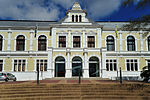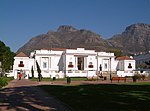Gardens Commercial High School
1968 establishments in South AfricaSchools in Cape Town
Gardens Commercial High School is a coeducational inner city Secondary School in Cape Town, South Africa with learners aged 12–18 years. In 2006 the school was designated a Business, Commerce and Management (BCM) Focus School. As such, Gardens Commercial is part of an education intervention that aims to redress the Apartheid education system. The school is a lead institution that supports learners with exceptional interest, talent, interest or aptitude in the field of business, commerce and management. Gardens Commercial offers the following focus field subjects: Accounting, Business Studies, Economics and Computer Applications Technology.
Excerpt from the Wikipedia article Gardens Commercial High School (License: CC BY-SA 3.0, Authors).Gardens Commercial High School
Paddock Terrace, Cape Town Cape Town Ward 115
Geographical coordinates (GPS) Address Nearby Places Show on map
Geographical coordinates (GPS)
| Latitude | Longitude |
|---|---|
| N -33.930277777778 ° | E 18.415555555556 ° |
Address
The Paddocks
Paddock Terrace
8001 Cape Town, Cape Town Ward 115
Western Cape, South Africa
Open on Google Maps





